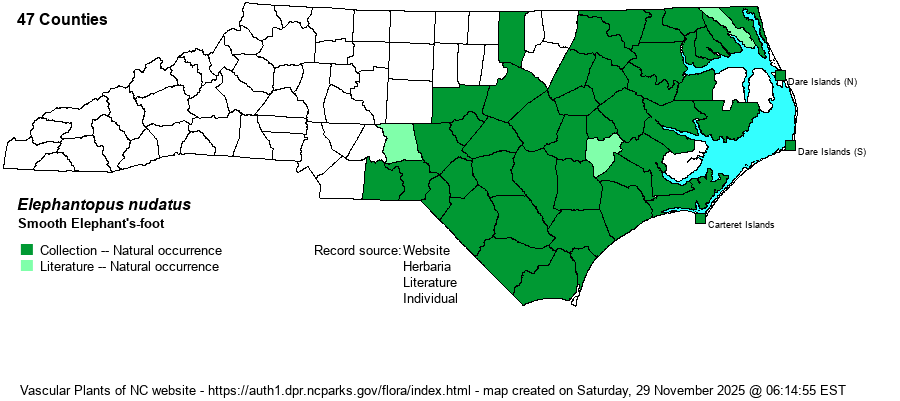| Author | A. Gray | |
| Distribution | Coastal Plain (including the Outer Banks), Sandhills, and lower Piedmont.
Mostly Coastal Plain, DE to northern FL, eastern TX, and AR; southward to northern S.A. | |
| Abundance | Frequent to common in most of the Coastal Plain, less numerous in a few coastal counties. Very rare along the eastern edge of the Piedmont. | |
| Habitat | Moist, seasonally wet, or mesic soils of pine savannas and flatwoods, blackwater streamhead ecotones, bottomlands, pine-oak-hickory-dogwood woodlands, and maritime forests. | |
| Phenology | Flowering and fruiting late July-September. | |
| Identification | Smooth Elephant's-foot has a few to several large, broad, basal leaves that form a rosette flat on the ground. The outer end is much the widest part of the leaf. One to a few stems grow 1-2.5 feet tall, generally hairy, terminated by several red-purple heads (disk florets only) sitting on 3 triangular leafy bracts. Common Elephant's-foot (E. tomentosus) is very similar but its stems are generally more densely hairy, basal leaves average wider, and the phyllaries (bracts which form the base of the head) are longer (10-13 mm long vs. 6-9 mm long). Both species can occur within a few yards of each other. | |
| Taxonomic Comments | None
| |
| Other Common Name(s) | Coastal Plain Elephant's-foot, Savanna Elephant's-foot | |
| State Rank | S5 | |
| Global Rank | G5 | |
| State Status | | |
| US Status | | |
| USACE-agcp | FAC link |
| USACE-emp | FAC link |

